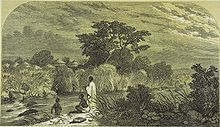User:SensualEthiopianPoliceBrigade/sandbox
Call to Africa[edit]

Call to Africa was a term used to describe European’s newfound interest in Dengel and other African states following World War I. It was one of the biggest factors contributing to Dengel’s Black Paris Movement and helped propel the country past the industrial period. It was also a turning point in discussions about race and colonialism in Africa, only a few years after the Scramble for Africa ended. The Call
to Afrika is of significant importance to French culture because of how influential the two nations became over each other’s arts, culture, and architecture. This led to the French coining the term “Les Blancs d'Afrique” (English: White Men of Africa) to refer to the Dengelese.
History[edit]
Much of the trend started immediately following the Gaberiounian Wars when British and French returned home with various artifacts and keepsakes. Influence quickly spread in France (and less-so in Britain) as little was previously known about Dengel. Only two months after the end of World War I, the Musée d’Moc in Paris held Europe’s first exhibition of Dengelese artifacts dating back to the Giro Period.
The term “Call to Afrika” was first used by Franco-Dengelese writer Markos Bravard in 1911 in his poem of the same name. The term was then re-used by the French newspaper Le Figaro in 1918 as the headline of an editorial about the unusually large amount of French tourism to Dengel.
For many European tourists in Dengel, it was their first encounter with a ‘black elite’. This helped change many Europeans’ views on Dengel. The term ‘white men of africa’ started to come into common use to describe the Dengelese who were considered more ‘western’ than other Africans. Embraced by the Dengelese, this helped bridge tensions between several ethnic groups and the Hararra within the country, as minorities now saw living in Dengel as advantageous over other countries. The new label also saw Dengel more involved in world affairs, even seeing England and Dengel form a defensive alliance in May of 1921.
Art[edit]

One of the most obvious changes was the shift in Dengelese art styles. Many French artists vacationed or emigrated to Dengel following the Great War and found themselves part of Dengelese artistic communities. Both the French and Dengelese artists saw major changes in their style. Post-impressionism started to become the dominant style in Dengel with such notable artists as Gebrewerk Astatke, Haile Rashem, and Albert Guilloux.
